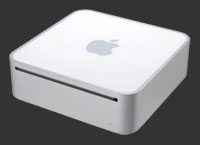The New iMac
A couple of rumors have been going around recently. The first, courtesy of Cringley, is that Apple will start including H.264 decoding and encoding hardware to all macs. very compelling, but i’ll address that a little more later. The second rumor, this one from Apple Insider, claims that the iMac is about to see it’s first major redesign since the iMac G5 was introduced. The new design will supposedly “cut the fat from the the current iMac line and outfit a pair of new Core 2 Duo-based models in a form factor that will be both slimmer and sleeker than today’s offerings.”
My guess is that both of these will be turn out to be true, sooner rather than later. Here’s why:
h.264 and AppleTV
 The AppleTV is an interesting clue. Here we have an interesting little device, capable of playing 720p h.264 video at 24 frames per second. According to Apple’s tech specs page, the AppleTV has a “Intel Processor” but that’s all we get. no word on any other real life hardware specs. What we do know is that according to Apple’s Quicktime HD System Recommendations, to play 720p h.264, you’d need at least the following:
The AppleTV is an interesting clue. Here we have an interesting little device, capable of playing 720p h.264 video at 24 frames per second. According to Apple’s tech specs page, the AppleTV has a “Intel Processor” but that’s all we get. no word on any other real life hardware specs. What we do know is that according to Apple’s Quicktime HD System Recommendations, to play 720p h.264, you’d need at least the following:
- 1.8 GHz PowerMac G5 or faster; 1.83 GHz Intel Core Duo or faster
- At least 256MB of RAM
- 64 MB or greater video card
So do we assume that the AppleTV meets these requirements? maybe, but maybe not. The cheapest Mac Mini is $599. Let’s compare these minimum requirements (the minimum the AppleTV could have according to system recommendation for Quicktime HD) to the cheapest Mac Mini:
The Mini has 256m more RAM. It also has 20GB more HD space (60 instead of 40). It has the same amount of VRAM, sort of. “Intel GMA 950 graphics processor with 64MB of DDR2 SDRAM shared with main memory” – which means that it doesn’t really have 256MB more RAM, but more like 190MB more after the graphics dips into it. The Mini also has a combo CDRW/DVDROM drive.
So is 200MB more ram, 20GB more, and a combo drive worth an extra $300? Admittedly, there are probably significantly more differences between these theoretical AppleTV specs and the Mac Mini, but keep in mind that the Mini does not have component video out, optical digital audio out, or (as far as i can tell) 802.11n. It is also possible that the AppleTV has more than 256MB ram or more than 64MB VRAM (and it is entirely possible that the AppleTV has the same shared 512 as the Mini.)
So either Apple is maintaining a far larger profit margin on the Mini than they are on the AppleTV, or, and here’s where the money is: maybe the AppleTV offloads the h.264 decoding to a hardware decoder, making all the quicktime HD minimum system recommendations irrelevant.
Should this be the case, it can’t be long before these chips make their way into the entire Mac lineup. I’ll spare you the obvious appeal of offloading decoding (and even encoding) to a hardware h.264 de/encoder enabling whimsical 1080p playback/recording in every mac sold.
So if H.264 chips are on the horizon, when will we see ’em? I’m guessing soon. Starting with the newly redesigned iMac.
How soon?
It’s All About Timing
 Let’s look at the history of the iMac. the original iMac was announced in May, 1998, but didn’t ship until August. It went through a few revisions, offered new and exciting colors, and enjoyed a long design lifetime.
Let’s look at the history of the iMac. the original iMac was announced in May, 1998, but didn’t ship until August. It went through a few revisions, offered new and exciting colors, and enjoyed a long design lifetime.
Then, 3 years and 4 months later, in January of 2002, the first major redesign was announced: the long-rumored flat panel iMac. This saw the addition of a larger 17″ model, some speed bumps and the addition of USB2.0 in 2003.
This flat panel G4 iMac lasted only 2 years and 7 months, and was the second major iMac design. The third, and most recent design (the second major redesign), was the G5 iMac, announced in August, 2004. This is essentially the same design as we see today in the Intel iMac (introduced, without any significant design changes, in January 2006).
So the original iMac design had a shelf-life of 3 years and 4 months. The flat panel G4 iMac lasted 2 years and 7 months. The current design? As of this writing, it’s been around for 2 years and 7 months.
The original iMac was announced in May, and shipped in august. The G4 iMac was released in January, the G5 iMac was announced August, and the Intel iMac (of the same design) was introduced in January last year.
I don’t necessarily want to say that this is a predetermined pattern, but… you do see a pattern, right?
Gimme Gimme
The final reason that i think these rumors have some substance: because i want to. I’ll (hopefully) be in the market for a new mac in the next few months, and i really want a redesigned iMac. I can not justify dropping 3 or 4 grand on a decently equipped MacPro, but i want to essentially go as high end as possible otherwise. Now (near May, really) would be the ideal time for me, and so i suppose i have my iMac-colored glasses on.
Final Word
Here’s my guess: we’ll see redesigned iMacs, with h.264 hardware of some sort, they’ll be Jonathan Ive’s patented sexy, and we’ll see them sometime between May and August.
I will, however, put the “they’ll include sort of new touch-screen craziness” portion of the rumors in the “doubt it” pile.
 the-ish.com/blog
the-ish.com/blog